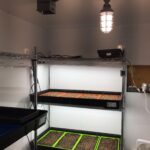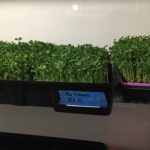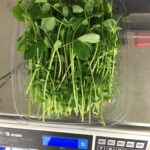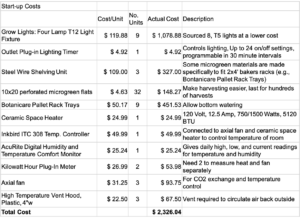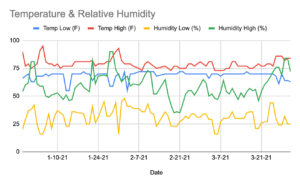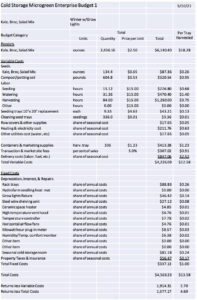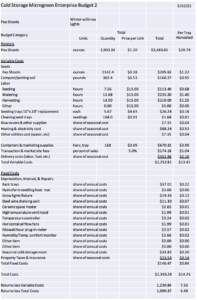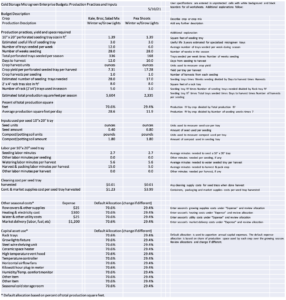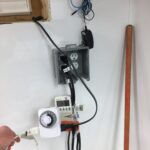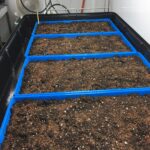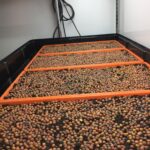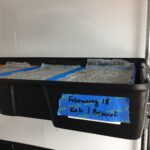Final report for FNE20-966
Project Information
Microgreens are a popular crop with both growers and consumers. With low start-up costs, a short growing period (typically between 13-25 days), potential to grow year-round, and high retail value, microgreens are an appealing crop for farmers. For consumers, microgreens are tasty and easy to prepare, with high nutritional value. Given the potential of growing microgreens under lights in the winter, they hold a special appeal to farmers in the Northeast, where the growing season is short and farm income is low over the winter months. For this research project, we (1) explored the feasibility of growing microgreens in a modified cold storage room under lights, and with supplemental heat; and (2) determined if growing microgreens in this arrangement is economically viable (profitable). To evaluate production methods, we grew four varieties of microgreens (kale, broccoli, mild salad mix, and pea shoots) full spectrum lights. We harvested and weighed marketable microgreens by variety. To assess economic profitability, we tracked start-up costs, as well as all production costs including electricity for heat, fans, and lighting. We found that maintaining moisture in the soil medium was key to even germination. Mold was not an issue in our operation, but was monitored for daily during inspections. Given the 36, 10x20 tray capacity, 504 trays can be seeded in a 28-week season. On average, the microgreens (across varieties) yield 7.31 ounces/tray (significantly less than the Johnny's Seeds 2017 Micro Greens trial) and pea shoots yield 17.28 ounces/tray. Labor for harvesting and packing is the biggest variable cost (15 min/microgreen tray and 5 min/pea shoot tray). Our budget analysis suggests that startup costs ($2,326.04) could be recovered in year one, with a net income (returns less fixed and variable costs) of $1,577 (12 trays microgreens/week) and $1,090 (6 trays pea shoots/week).
Most small scale farms have cold storage rooms, which are typically only in use during the summer months to keep products fresh for market, but sit idle during the colder months. Making a few minor modifications to existing farm infrastructure (cold storage rooms) to grow microgreens, a high-value crop, could be a simple and cost-effective way of supplementing farm income. Given that microgreens can be grown vertically under lights, their production could be an efficient use of small spaces.
We have two main objectives for this study. We aim to (1) explore the feasibility of growing microgreens in a modified cold storage room under lights, and with supplemental heat; and (2) determine if growing microgreens in this arrangement is economically viable (profitable).
According to the US Agricultural Census, over 70% of New Hampshire farms sell less than $10,000 of products, and 68% (2,821) of the state’s farms reported net losses in 2017. Making a livable income in small-scale farming is challenging, particularly in New England where the growing season is short. For many fruit and vegetable farmers in the Northeast, farm income slows down from late fall through winter, and doesn’t pick up until mid to late spring. Many farmers grow storage crops and cold-hardy crops in high tunnels, and some farmers sell community supported agriculture (CSA) shares to increase farm income through the winter. However, for small-scale farms that don’t have production space to grow storage crops (e.g., squash, cabbage), cold season infrastructure (e.g., high tunnel), and/or where CSA’s are not economically feasible due to scale, finding alternative sources for winter farm income could help increase farm viability.
Northern New England has a short growing season, and many small-scale farmers have low to no income over the winter months. Through this study we aim to determine the feasibility of growing microgreens in a modified cold storage room from October through April, when these rooms otherwise sit idle. As cold storage rooms are heavily insulated, and outfitted with electricity (typically air conditioning units are used to keep the space cool), minor modifications are required to make the space conducive to growing microgreens. By adding and/or modifying shelving, adding heat- space heater and heat mats- and lights, a small space can become productive. We propose to explore if modifying an existing cold storage room with supplemental heat and lights is conducive to growing microgreens through the coldest months of the year. Microgreens are popular with consumers and have proven to be a profitable crop for farmers when grown high tunnels, but heating high tunnels through the coldest months of the year can be costly. As most farms have cold storage rooms and microgreens can be grown under lights, modifying existing infrastructure could prove to have low startup costs and high income potential, contributing to overall farm viability. Having farm-generated income during the winter could decrease the need for farmers to seek off-farm employment and potentially keep employees year-round.
Cooperators
Research
The study took place in the cold storage room at Fat Peach Farm, which is 8’x7’ (56 sq2, 5.2 m2). Three walls fit one wire rack each, with three shelves per rack, accommodating 12, 10 x 20” trays per rack at any given time for a total capacity of 36 trays. We started out by filling 16, 10x20 flats each week for the three months. Trays were filled with pre-moistened Vermont Compost Co. Fort Vee Compost-Based Potting Mix. Wet media is slow to warm up, which may affect speed of germination. However, room temperature was ideal for seed germination and did not require the use of heat mats. We weighed microgreen seeds by variety and ensured that the same amount of seed (0.4 oz for the three microgreen varieties and 6.8 oz for pea shoots) was evenly distributed across the prepared trays. To promote germination, we pre-soaked pea seeds in fresh, cold water for eight hours prior to seeding into trays. We also covered microgreen trays with 10”x 20” sheets of floating row cover (Agribon) and sprayed with water to soak the cover and ensure contact with seeds and soil. Similarly we placed an empty 10x20 tray on top of the pea seeds to hold in moisture and ensure the seeds stayed in contact with the soil. Agribon and trays were removed after germination. Seeded trays were placed on the metal shelving under fluorescent grow lights, and bottom watered as needed. We hung the lights 17in (43cm) above the trays and upon germination ran them for 14 hours in a 24 hour cycle until harvest.
As the growth of mold was of particular concern, we sterilized growing trays with food grade hydrogen peroxide and white vinegar prior to filling with soil (following the National Organic Program list of allowed and prohibited substances). This step was repeated after each harvest. We addressed air circulation by including 3 horizontal airflow fans to ensure good air flow. Additionally, we seeded microgreens in perforated trays and placed them in Botanicare® 2 ft x 4 ft Rack Trays, which allowed us to water from below and reduce the chance of overwatering and damping off. We top watered as needed (e.g., if the trays were unevenly dry and bottom watering would saturate the soil). We also monitored humidity to ensure humidity levels remained around 50% (regulated with a horizontal fan pulling in fresh, cold air from outside). We did not see mold forming anywhere inside the grow room. Some mold did appear around the door into the grow room—on the inside of the door frame—which did not affect microgreen production.
A ceramic convection heater was plugged into an Inkbird ITC 308 Temp. Controller, which was set at 3 degrees F above/below 75. Temperature was recorded 24/7 using a dual thermometer and hygrometer, which provided a 24 hour high and low for both temperature and humidity, as well as real time temperature and humidity readings. Electricity use was recorded for lights, and heat, and fan with a kWh with a plug-in Kill a Watt hour meter. As the light ballasts produce heat, we ran lights, controlled by a timer,14 hours/day from 6 PM to 8 AM during the coldest part of the 24 hour cycle. The heater ran as needed (controlled by the Inkbird) to maintain desired temperature (75 F / 23 C), mostly during the day when the lights were turned off.
After working through issues with uneven watering and high temperatures due to the heat generated by the lights, and producing a consistent product, we developed relationships with three vendors and adjusted the number of trays accordingly. From February through March of this experiment, we seeded 11 trays/week, 5 pea shoots, and 2 each of the microgreens. We harvested the microgreens and weighed them on a certified scale, recording the weights by variety by tray.
We measured the total cost of materials (setup: shelving, lights, heater, and InkBird Temperature Controller, thermometer and hygrometer, 10x20 trays, Botanicare trays), electricity (heating, and lighting by kWh), and yield by variety. We also measured each item for an average cost per variety (i.e., the cost from seeding to packaging), with one figure for start-up cost (Table 1).
We proposed to seed 24 trays each week, with 48 trays in production at any given time. However, the lights we purchased (Prism Lighting Science HO T5 V2 4', 4 Bulb Fluorescent Fixture w/ Bulbs - 120/208/240/277v), while 4ft (1.2m) in length, have cords that reach 2in (5cm) beyond. Accounting for the cords/plugs, we were unable to fit the proposed number of trays. We therefore reduced the number of trays to 12 per wall, allowing us to fit 36 trays total.
At the start, we experienced issues with uneven watering. Although the Botanicare trays measured as level, water seemed to pool, soaking some trays and leaving dry patches in others. We resolved this issue by cutting 10”x20” sheets of row cover (Agribon) to place on the surface of the microgreen trays. This allowed us to water with a sprayer (top down), the cover holding moisture against the seeds. The cover was removed after germination and we switched to bottom watering.
We installed two small axial fans mounted in the window, which bring in fresh, cold air and help to regulate the temperature and humidity levels. This system has worked well for humidity, though has not worked as well for maintaining optimal temperatures when all 8 lights are running. To mitigate the spike in temperature under the current set up, we left the door open about 2” to allow more air exchange. This worked well, however is not as efficient as an appropriately sized fan and temperature controller. A larger fan and louvre are needed to lower the temperature when all lights are running.
Figure 1. High and low temperature and relative humidity of modified grow room. Measurements were taken daily over the course of the study.
We aimed to modify a cold storage room originally developed for use with a CoolBot in the warmer months, into a grow room to produce a variety of microgreens and pea shoots. Through this research, we determined that the modified cold storage room is excellent at maintaining heat and allowed for efficient production of three microgreen varieties, as well as one variety of pea shoots. The super insulated room was kept warm with a small ceramic heater and heat emitted by the fluorescent lights. Additional heating with mats was not required. However, when the room is set at max capacity, with all lights running, temperatures reached well above the set range of 75-78 F / 23-25.5 C.
The set up (trays, soil, lights, etc.) are conducive to growing marketable microgreens and pea shoots. Our budget analysis suggests that startup costs could be recovered in year one.
I reached new markets and generated a new revenue source during winter months, a time when our farm income is low. I plan to increase the number of units sold next year, as I find new market outlets. In this trial, pea shoots were the easiest to seed, water, and harvest of the four varieties; though all three microgreen varieties yielded higher gross and net income.
Education & Outreach Activities and Participation Summary
Participation Summary:
To date, I have given two farmer tours of the operation and one tour with sustainable agriculture students from UNH. I have developed newsletter content, which reaches an audience of 241, with 44.7% open rate. The newsletter audience consists mostly of customers and a handful of local farmers. I have also posted several social media posts on Instagram where we have 590 followers, with a 10-15% engagement rate. Our Instagram account reaches more farmers across a larger geographic range than the newsletters.
I will continue to update my audience via newsletter and social media, and work with UNH Cooperative Extension to host a tour of the operation specifically for farmers, either in person or virtual in 2021.
I developed a farmer fact sheet about microgreen production in a modified cold storage and plan to present findings at several farmer conferences in 2021/22.
ColdStorageRoomMicrogreenGuide
Learning Outcomes
I gained skills around growing microgreens in a controlled environment, a new experience for me; my farming experience to date has been limited to outdoor growing during the spring, summer, and fall. Working with my Technical Advisors, I also learned new methods of calculating an enterprise budget.
Project Outcomes
We are excited about the prospect of developing a new source of revenue during months when farm income and activity is low. We have developed new markets and are looking to cultivate relationships with new vendors after we address the overheating issue. We are planning to solicit 2-3 more vendors for next winter to maximize the number of trays in production each week. We plan to create a regular seeding rotation, seeding 18 trays every 7 days and harvesting 18 trays every 12-15 days.
ColdStorageRoomMicrogreenGuide
Involvement from UNH Cooperative Extension staff was key to the success of this project. Specifically, Cooperative Extension greenhouse field specialists Jonathan Ebba and Muhammad Shahid offered assistance on the setup of the space to ensure best practices for lighting, air flow, and production; agricultural business specialist Mike Sciabarrasi also assisted with developing cost-benefit analyses to help determine the economic viability of this project. And my technical advisors Kenesha Reynolds, Agricultural Business State Specialist; and Jeremy DeLisle, Fruit & Vegetable Production Field Specialist offered support throughout the study.
Given my experience with this pilot study, I plan to continue producing microgreens in our modified cold storage room next year. I plan to change the air intake to include a larger fan and louvre to better regulate the temperature and allow for maximum use of the space.
Most small to mid-scale fruit/vegetable growers have cold storage rooms as part of their farm infrastructure. Farmers producing in an area with cold winters, and access to interested markets, can consider modifying their cold storage room and/or build a grow room for microgreen/pea shoot production during the winter months.
Future research of the feasibility of growing different varieties of microgreen or other crops in modified cold storage rooms; and exploring different lighting options (e.g., LED v. fluorescent) would be useful. Additionally, research exploring the differences in cold storage room infrastructure (insulation as well as lighting) could offer insight into energy use and efficiency based on R values.
